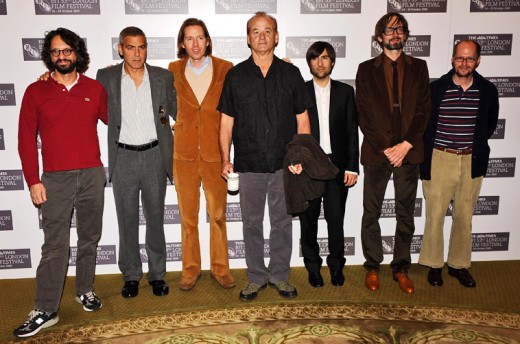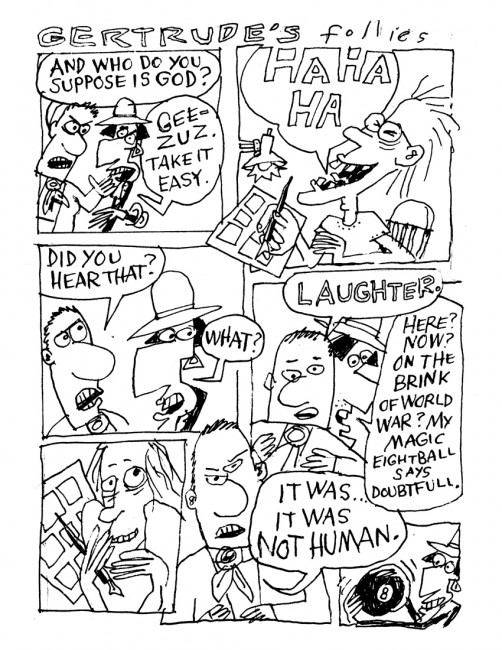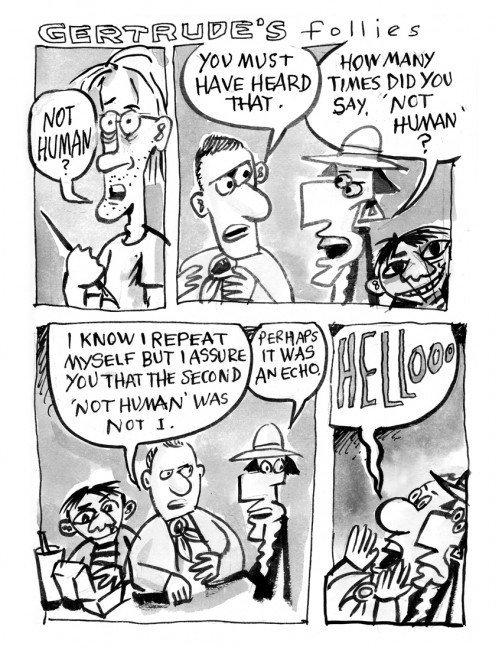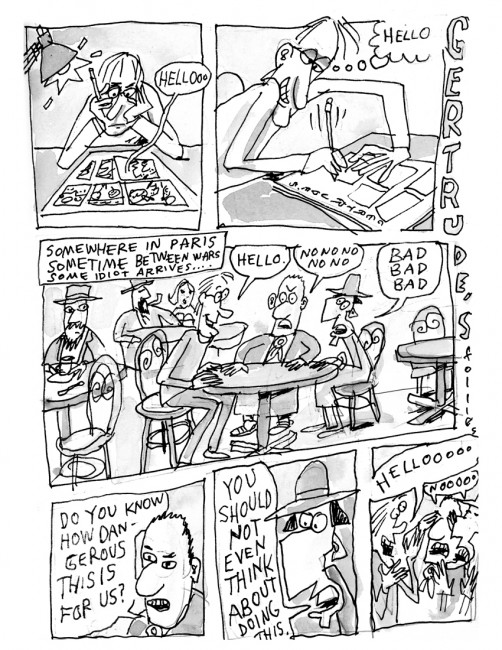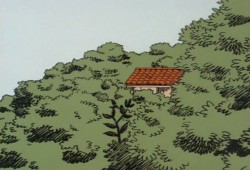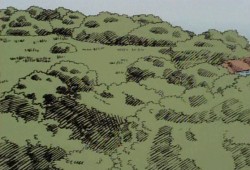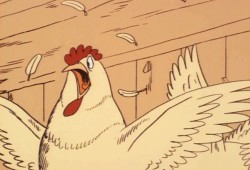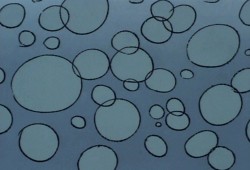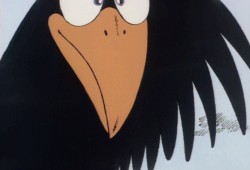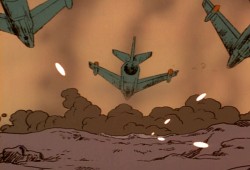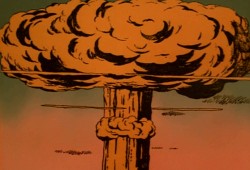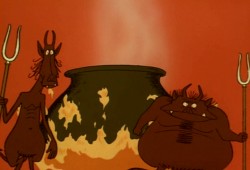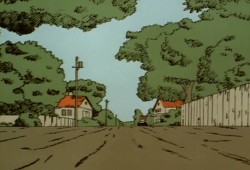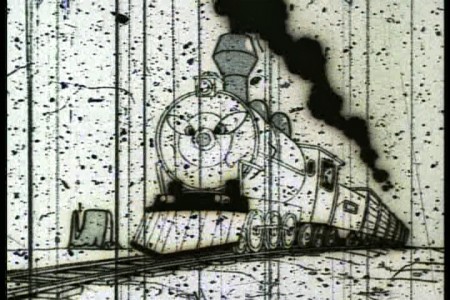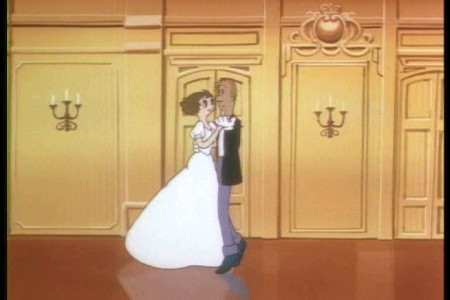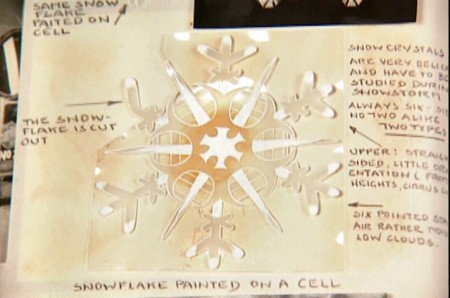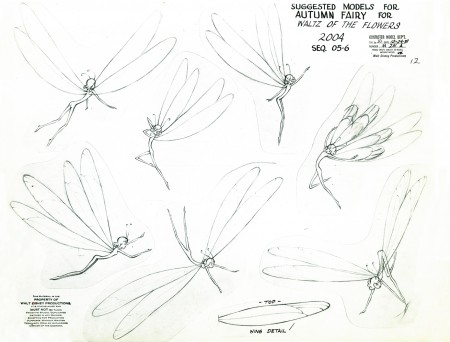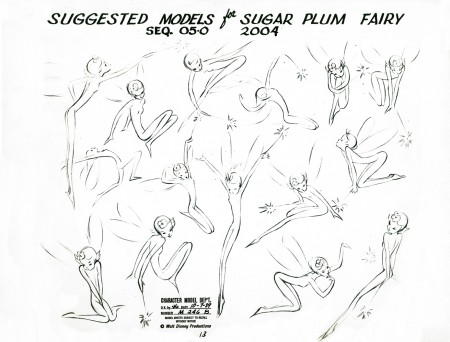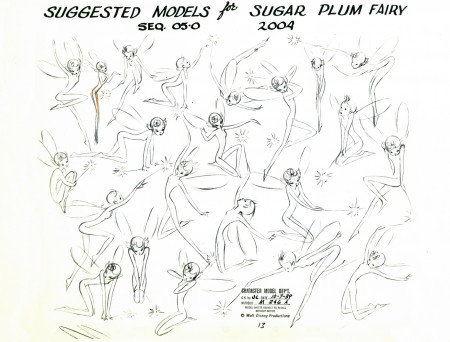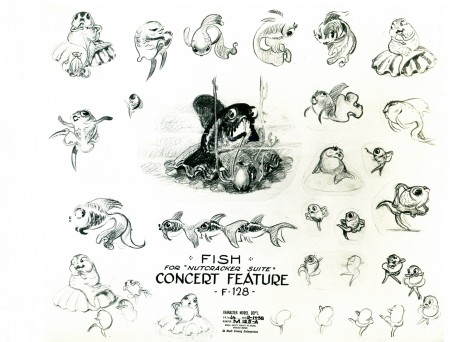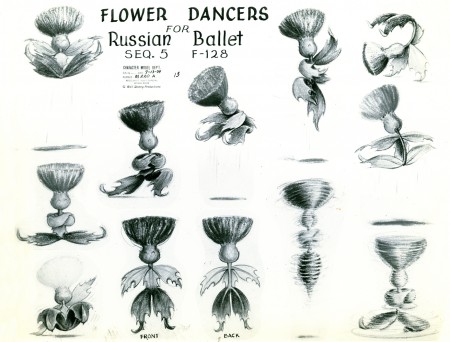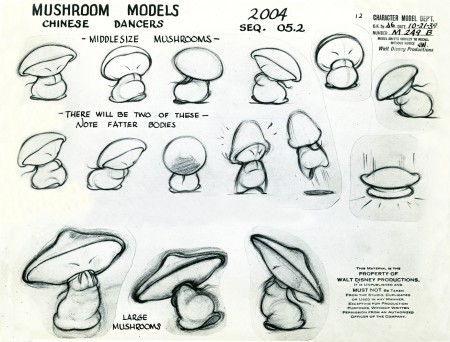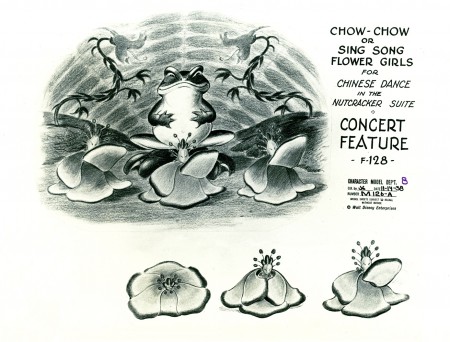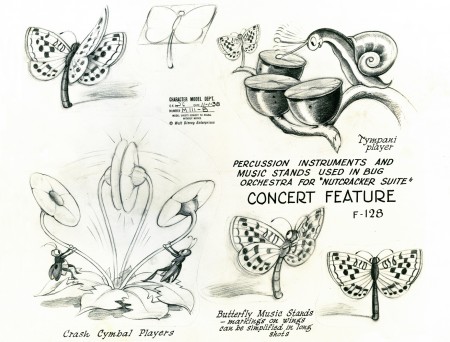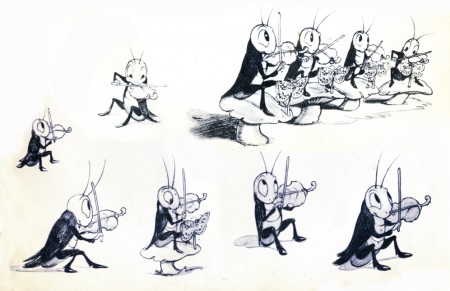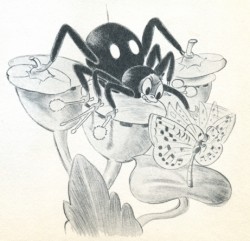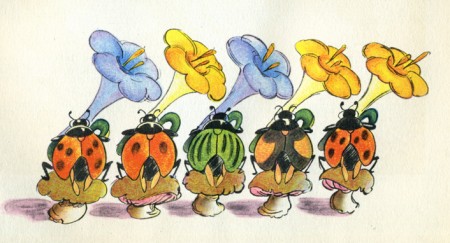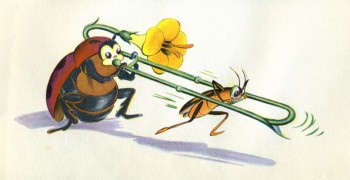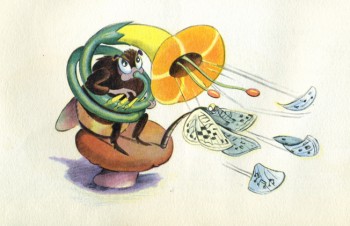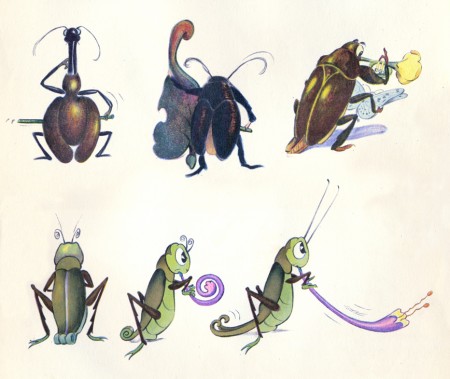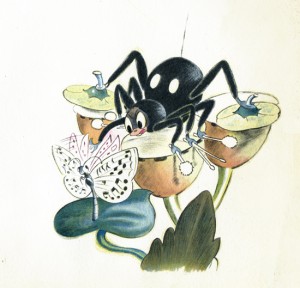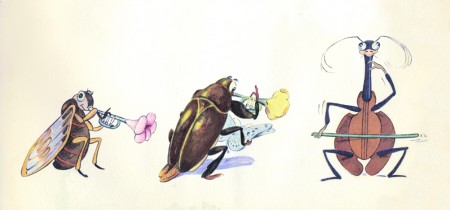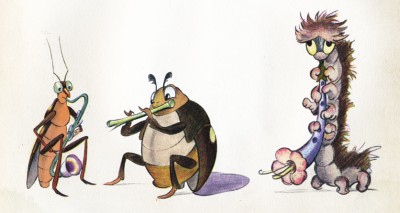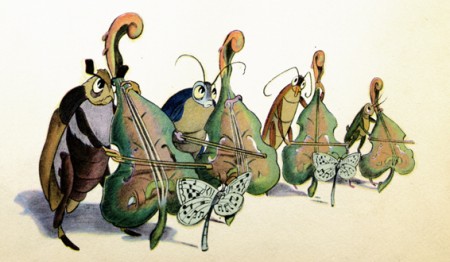Search ResultsFor "fantasia"
Animation &Commentary &Events 06 Jan 2010 08:54 am
Russian Animation
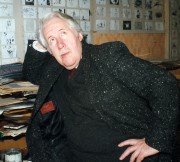 - Andrey Khrzhanovsky is one of Russia’s premiere animators. The list of his an1mated shorts can be found here.
- Andrey Khrzhanovsky is one of Russia’s premiere animators. The list of his an1mated shorts can be found here.
He has completed a live action/animation feature that has been scoring excellent reviews. A Room and a Half draws on the biography of Joseph Brodsky, the Russian -Jewish -American poet, who won the Nobel Prize for literature in 1987 and was made poet laureate of the U.S. in 1991.
The reviewer in Variety wrote:
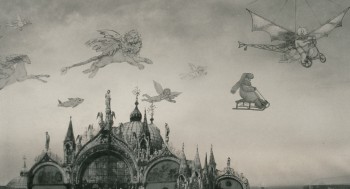 Veteran animator and documaker Andrey Khrzhanovsky’s feature debut, at the age of 69, is a magical, wildly creative fantasia on the life of Russian poet Joseph Brodsky. . .
Veteran animator and documaker Andrey Khrzhanovsky’s feature debut, at the age of 69, is a magical, wildly creative fantasia on the life of Russian poet Joseph Brodsky. . .
Khrzhanovsky has stated that Brodsky’s life was the “creative impulse†for his film, meaning it shouldn’t be seen as a biopic. Or rather, it’s as much a biopic as one of Fellini’s self-referential reveries. . .
“A Room and a Half†is unmistakably the work of a mature artist, and it’s the helmer’s absolute mastery of the different formats that makes his work so joyous. Silhouette cutouts reflect pre-Revolutionary elegance, an animated cat appears inside a credenza and musical instruments float across the city skyline, fusing Magritte and Chagall.
The magazine Screen adds:
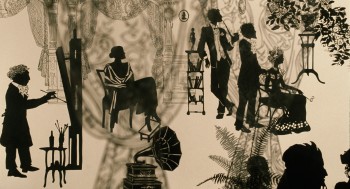 Some of the most touching moments in the film cover his childhood, painting an intimate, cheerful, closely knit family, that never lets their cramped living space or the penury of the lean years sap their spirit. The film freely elaborates on young Brodsky’s flights of imagination at the time, including a magical animated sequence in which Soviet soldiers throw culture out of the window, followed by a whole orchestra’s worth of instruments.
Some of the most touching moments in the film cover his childhood, painting an intimate, cheerful, closely knit family, that never lets their cramped living space or the penury of the lean years sap their spirit. The film freely elaborates on young Brodsky’s flights of imagination at the time, including a magical animated sequence in which Soviet soldiers throw culture out of the window, followed by a whole orchestra’s worth of instruments.The Film Forum will be screening A Room and A Half for two weeks beginning Jan 20th.
.
- Speaking of Russian animation, there’ve been some additions to Niffiwan’s site, Animatsaya In English. Lots of recent animation has been posted (all subtitled in English) as well as a lot of information.
Niffiwan has put together a Wiki site which offers a large number of animated films, both current and historic, which have been subtitled. There’s a list of films subtitled in English and a list of films that are wordless. You owe it to yourself to start catching up on some of the world’s finest animation.
Some of the treasures include:
-
Of course, there are Norshtein‘s films: The Heron and the Crane and The Hedgehog in the Fog
There’s also Fyodor Khitruk‘s masterpiece Film, Film, Film as well as several of his Winnie the Pooh flms.
There are number of films by Edouard Nazarov including There Once Was A Dog.
There are classics like Ivan-Vano-Ivanov‘s The Little Hunchbacked Horse or The Stolen Sun.
Plenty (maybe too many) of the commercially successful Well, Just You Wait! films.
Get a taste of the Russian Roadrunner, then move on.
There are at a couple hundred films on this site. Spend some time.
Additionally, Niffiwan leads us to another site: Digital Cake which offers some other animated films (many are the same as his wiki.)
Commentary &T.Hachtman 28 Nov 2009 08:51 am
Fox/List/Gert
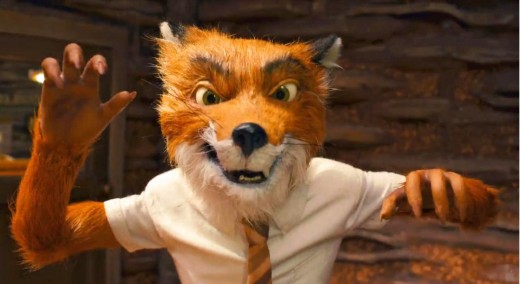
The Fantastic Mr. Fox – Did I tell you often enough that I really like this movie? One director – one voice. Independent spirit. Relatively low budget – $40 million. See it for fun.
- There’s a solid interview with Wes Anderson on the always enjoyable Onion’s AV CLub. His comments are worth reading, expecially if you’ve seen the film.
- Rotten Tomatoes, on the arrival of Disney’s The Princess and the Frog, has created a listing of Disney animated features and organized them into a list of titles. The order of the list is determined by some shaky criteria. Per Rotten Tomatoes: We used a weighted formula that takes into account the Tomatometer, number of reviews, and release year of every film included. We excluded all Disney subsidiaries and companies through which Disney has distribution deals hence, no films from Pixar, Studio Ghibli, or DisneyToon Studios are on the list.
Here’s their listing. Each title is followed by the Tomatometer rating:
- 1. Pinocchio 100%
2. Snow White 98%
3. Fantasia (1940) 98%
4. 101 Dalmatians 97%
5. Dumbo 97%
6. Beauty & the Beast 93%
7. Lion King 92%
8. Aladdin 92%
9. Cinderella 92%
10. Sleeping Beauty 91%
11. The Little Mermaid 90%
12. Bambi 89%
13. The Jungle Book 89%
14. Bolt 88%
15. Tarzan 88%
16. Lady and the Tramp 87%
17. Mulan 86%
18. Emperor’s New Groove 85%
19. Lilo and Stitch 85%
20. The Rescuers 84%
21. Fantasia 2000 82%
22. Hercules 83%
23. Peter Pan 83%
24. Alice In Wonderland 81%
25. The Hunchback of Notre Dame 72%
26. The Sword in the Stone 73%
27. Treasure Planet 70%
28. Meet the Robinsons 66%
29. Dinosaur 65%
30. The Aristocats 65%
31. The 3 Caballeros 87%
32. The Fox and the Hound 71%
33. Pocahontas 56%
34. Home on the Range 55%
35. Robin Hood. 55%
36. The Black Cauldron 58%
37. Atlantis: the Lost Continent 46%
38. Oliver and Company 44%
39. The Adventures of Ichabod & Mr. Toad 89%
40. The Rescuers Down Under 60%
41. The Many Adventures of Winnie the Pooh 91%
42. The Great Mouse Detective 79%
43. Brother Bear 38%
44. Chciken Little 36%
45. Saludos Amigos 70%
46. Melody Time 88%
47. Make Mine Music 67%
48. Fun and Fancy Free 67%
Just to amuse myself, I sought out all the Don Bluth films and compared their Tomatometer ratings to see which would be hightest. No surprises, except maybe that American Tale was rated so low. These aren’t graded the same way the Disney films were, above. Some of Bluth’s films weren’t rated:
- The Secret of NIMH 94%
Anastasia 85%
An American Tale 63%
Titan AE 51%
All Dogs Go to Heaven 44%
The Pebble and the Penguin 36%
Thumbelina 25%
Rock-A-Doodle 20%
Continuing the process let’s look at Ralph Bakshi‘s films. He didn’t fare as well as Bluth; some of Bakshi’s films weren’t reviewed either:
- Heavy Traffic 88%
American Pop 56%
Fritz the Cat 53%
Wizards 53%
The Lord of the Rings 47%
Cool World 6%
- After posting Tom Hachtman’s Renaissance Masters the past four weeks, I’m sort of out of sorts to not have any more of it. Let me post a couple of Gertrude & Alice cartoons to fill the void:
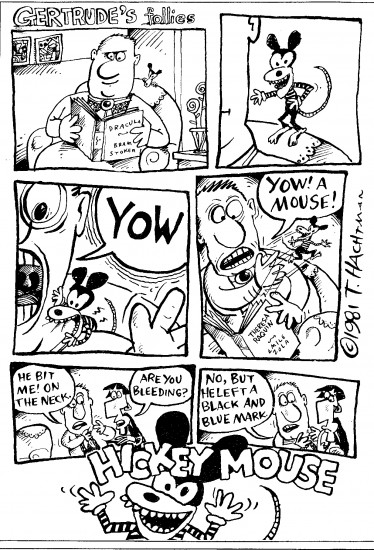
This one could be a comment on the “Twilight” experience.
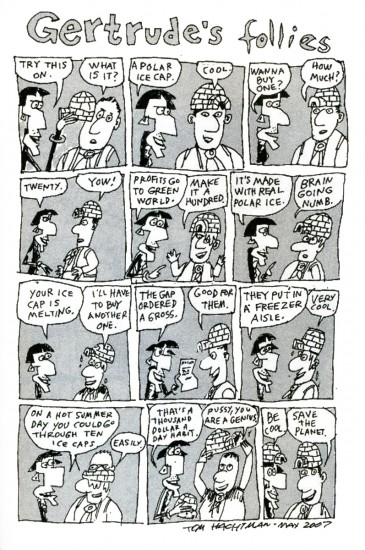
This week I heard about the after-show auction going on
at A Steady Rain‘s Broadway performances. Hugh Jackman &
Daniel Craig are raising cash for Broadway Cares by having
after-show auctions of their “sweaty” T-shirts.
Gert & Alice can do it for the environment.
And while I’m at it, let me post one of my favorite strips (which I’d posted once before.)
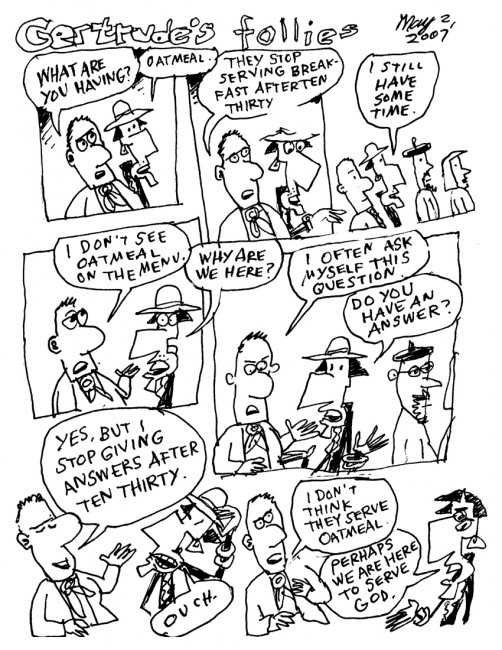
(Click any image to enlarge.)
Commentary 20 Nov 2009 08:53 am
Tezuka on DVD
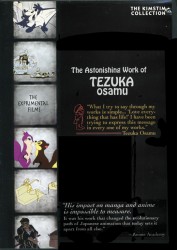 - Kino Video has an excellent DVD available of the work of Osamu Tezuka. Called The Astonishing Work of Osamu Tezuka, the disc covers a wide range of this truly experimental filmmaker’s films.
- Kino Video has an excellent DVD available of the work of Osamu Tezuka. Called The Astonishing Work of Osamu Tezuka, the disc covers a wide range of this truly experimental filmmaker’s films.
He was probably most famous for the Manga he created which became Astro Boy. The creator of the big-eyed cartoon character, he’s often credited as the father of Anime. This video contains none of that work.
What it does include, is a number of shorts – 15, to be exact, – which are always interesting, sometimes peculiar, and in a couple of cases great.
For me two films stand out: Jumping and Broken Down Film.
Jumping is a tour-de-force of animation. The camera acts as the eyes of a jumper, bouncing up and down and through an animated landscape. As the camera bounds up and down, higher and lower, more and more violently, everything animates in a wide perspective. It ends the way it starts; after the complete evolution and destruction of society, it returns to the beginning. The film is brilliantly animated by Junji Kobayashi.
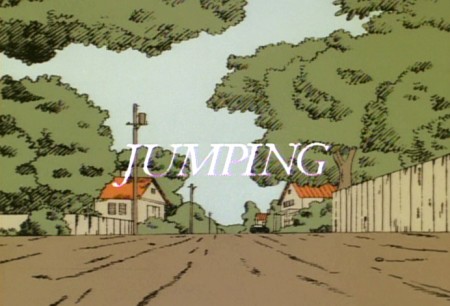
(Click any image to enlarge.)
Jumping (1984) is on YouTube, but the transfer is bad. Low Res and out of sync. It’s an excellent film, but this version becomes annoying quickly.
Broken Down Film is an exercise in recreating a horrible film experience – watching an old film that falls apart before our eyes. However, as if it were a Tex Avery cartoon, the dirty, scratchy print affects the characters as well.
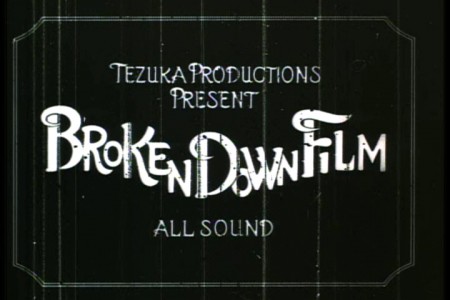
Right from the title, we are treated to violent scratches in the film.
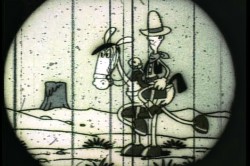 2
2 3
3
A cowboy on his horse has to deal with the jumping film gate.
He corrects it by pushing the frame back in place.
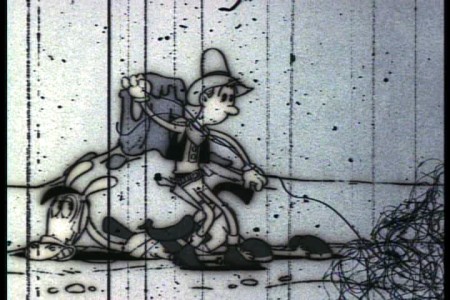 4
4
However, then there’s the lint at the bottom right.
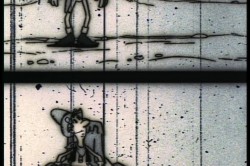 5
5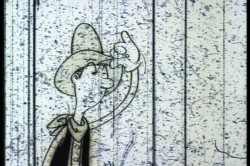 6
6
The film jumps again, but
he hears a damsel in distress.
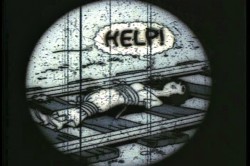 7
7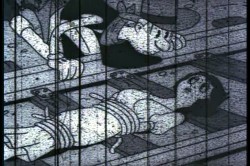 8
8
He moves in to help the girl but there’s too much snow.
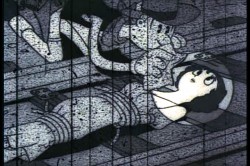 9
9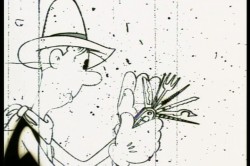 10
10
He wipes some away and pulls out his swiss army knife.
to cut the rope that binds her.
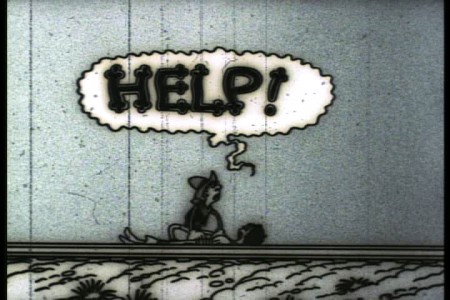 12
12
He takes the “Help” balloon . . .
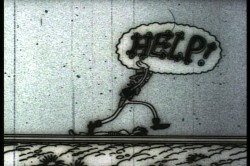 13
13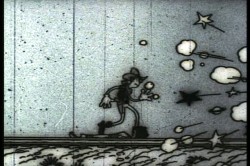 14
14
. . . and throws it in front of the train.
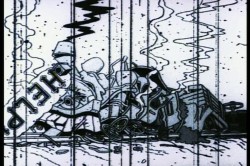 15
15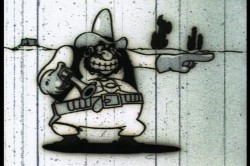 16
16
After taking care of an oncoming train,
there’s the villain shooting at him.
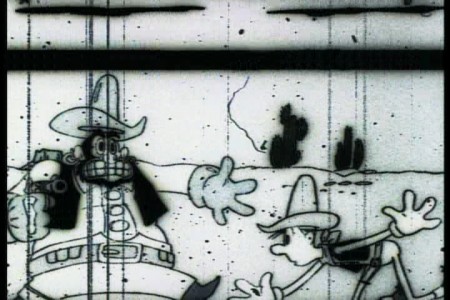
The jumping frame knocks them both off their centers.
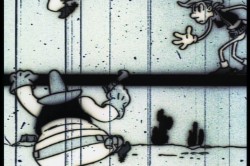 18
18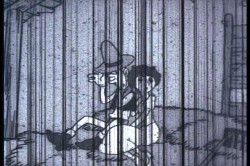 19
19
Good guy traps the villain in the film frame
and goes back to the girl in the scratched frame.
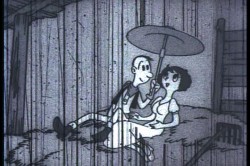 20
20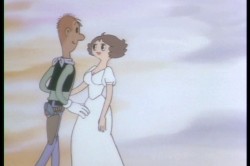 21
21
He truns his hat into an umbrella to clear the raining scratches,
and the image turns into a color musical.
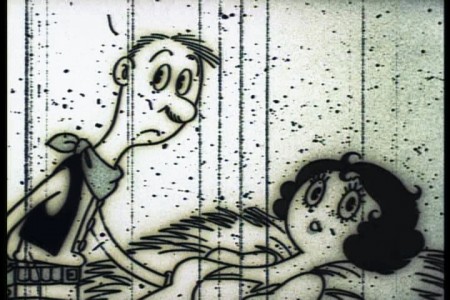 23
23
Until it suddenly goes back to B&W.
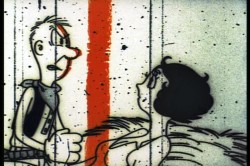 24
24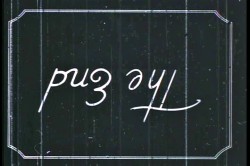 25
25
They can’t even kiss. The china marker comes off
on his face. Annoyed, but the image splits to the End credit.
Broken Down Film (1985) on YouTube. It’s not a bad version.
The DVD is expectedly, excellent quality. It also includes a lengthy interview with Tezuka who goes through each of his films. His films are quirky, but I’m glad to have them in my collection.
- Miyazaki has a brief chapter about Tezuka in his book, Starting Point: 1979-1996. He does not have very positive things to say about the older director, Tezuka.
- I found myself disgusted by the cheap pessimism of works like Ningyo (Mermaid), or Shizuku (The Drop), which showed a drop of water falling on a thirsty man adrift at sea. I felt that this pessimism was qualitatively different from the pessimism Tezuka used to have in the old days, as in the early days of Atom (Astro Boy), for example—but it also could have been that in the early days I felt great tragedy and trembled with excitement at Tezuka’s cheap pessimism precisely because I was so young.
And later in the essay he continues:
- From a senior of mine in the industry, I once heard that when Tezuka was working on the production of the Saiyuki (Alakazam the Great) animation feature, he reportedly advocated inserting an episode showing the hero monkey, Songoku, coming back and finding his girlfriend (also a monkey) dead. But there was never any reason for the girl monkey to be dead. When I learned from other people that Tezuka had advocated this simply because “it would be more moving,” I fully realized that I could part ways with him.
Finally, he concludes this essay:
- The end of the Showa period
(Dec 25 1926- Jan 7 1989 – The era of Emperor Hirohito)
Overall, my opinion of Tezuka is as follows: I appreciate him for being the person to pioneer story manga, and for having created the current of the times in which we work today. So when writing or speaking about him in public, I have always referred to him with respect as “Osamu Tezuka.” And this is because he was not just my rival, but also my predecessor. I have written about him exactly the same way I would write about some other famous historical figure from the past, like Hirobumi Ito. And I think I am correct to appreciate him in this way.
In terms of animation, however, I think I have the right and responsibility to say the following—everything that Mr. Tezuka talked about or emphasized was wrong.
Why did such an unfortunate state of affairs arise? I think, as can be seen from Tezuka’s early manga works, it is because his starting point was Disney. Because in Japan at the time there was no one who could be his teacher, no one he could emulate, Tezuka’s early works are almost all just imitations of Disney. To them he merely added his own narrative element. I say added, but his worlds continued to be created under huge influence from Disney. As a result, he always had an inferiority complex, a fear that he would never be able to surpass “the grand old man.” That’s why he always thought that he had to outdo Disney’s Fantasia, or Pinoc-chio, and why he was never able to overcome his compulsion to do so. At least that is my interpretation. It becomes understandable if you think of his work in animation as a hobby—something a rich man might do for a diversion.
When I heard that Tezuka had passed away, I truly felt that it was the end of the Showa era, even more so than when I heard that the Showa Emperor himself had passed away. Tezuka was a ferociously active person, and in his life he probably accomplished three times more than most people do. So given that he died at sixty, he really lived a hundred and eighty years’ worth. I think that he truly lived a full life.
Animation &Independent Animation 22 Oct 2009 07:53 am
Pups of Liberty – Interview
- I’m an Independent Director/Animator/Producer of animated films. As such I watch closely what else is going on independently in the world of animation. I try to keep up with most of the short films made and being made; I try to keep up with all the people involved in that world.
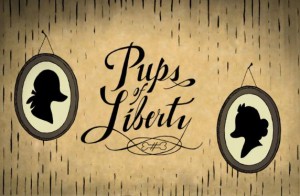 In the old days, one had to go to the Festivals around the world to see these films. ASIFA East often brought some of these films and filmmakers to our local meetings, but generally you had to travel to see the average film. The big, famous award winners would always show up somewhere. Nowadays, the Internet has brought more films and artists into my life, and I get to see more of the less than sterling flms from around the world. Ian Lumsden’s Animation Blog has introduced me to many films I wouldn’t have even known to look for including many gems. Niffiwan‘s Animatsiya in English brings Russian films that would otherwise escape my notice. There’s a lot out there, and I keep looking.
In the old days, one had to go to the Festivals around the world to see these films. ASIFA East often brought some of these films and filmmakers to our local meetings, but generally you had to travel to see the average film. The big, famous award winners would always show up somewhere. Nowadays, the Internet has brought more films and artists into my life, and I get to see more of the less than sterling flms from around the world. Ian Lumsden’s Animation Blog has introduced me to many films I wouldn’t have even known to look for including many gems. Niffiwan‘s Animatsiya in English brings Russian films that would otherwise escape my notice. There’s a lot out there, and I keep looking.
The fortune of having a modestly successful blog is that some filmmakers actually approach me. Such was the case with Jennifer & Bert Klein‘s Pups of Liberty. They sent me a link to their site which offered a trailer for their short film, and they offered to send me a DVD of the entire film.
When I looked at their site and trailer, it was obvious this wasn’t your average short. I saw the very full animation, beautiful backgrounds, and I looked deeper.
I saw the credit list and the names of James Lopez (Animator on Hercules, Emperor’s New Groove, Flushed Away and Princess and the Frog), Eric Goldberg (Animator on Aladdin, Fantasia 2000, and Princess and the Frog), Barry Atkinson (BG artist on Prince of Egypt, American Tail and The Lion King), and Mark Henn (Animator Ariel, Belle, Jasmine, Mulan and Tiana) among others. I had to see this film.
I wasn’t disappointed. The animation is sterling in the richest of full animation; the Bg’s are beautifully styled to feel like the period (the Revolutionary War) they’re meant to suggest, and the Direction couldn’t be cleaner or clearer or more focused. The film doesn’t waste a shot, but drives itself through the story in a very economical approach. Yet not a dollar seems to have been spared in making this the extraordinarily lush film it is.
I had to respond to Jennifer and Bert Klein to ask for a short interview and they responded with answers to any question I posed and plenty of supportive material. Hence, I’ll post that Q&A today with some stills from the film, and tomorrow some amazingly attractive pre-production artwork. This film deserves a book of its own.
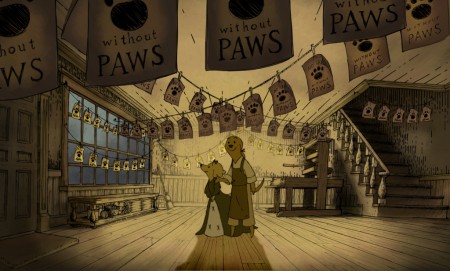
All images copyright © 2009 Picnic Productions
The Interview
Michael – What prompted you to develop this story? It reminds me a bit of Disney’s Johnny Tremaine in the way that it focuses on a particular craftsman and his daughter, just as the live action film focused on a silversmith and his apprentice. Was there any inspiration from that film/book? Animation wise, it feels a bit like Ben & Me. Perhaps that’s because of the subject.
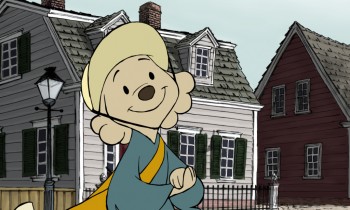 Jennifer – I have always loved this era of history (Colonial/Revolutionary America) so when I first began developing an idea for a new short it was the first setting that came to my mind. I wanted to make a story that was quality and that a viewer would feel good about watching; I was also very interested in how to teach people concepts (like taxation and representative government) with a media like animation.
Jennifer – I have always loved this era of history (Colonial/Revolutionary America) so when I first began developing an idea for a new short it was the first setting that came to my mind. I wanted to make a story that was quality and that a viewer would feel good about watching; I was also very interested in how to teach people concepts (like taxation and representative government) with a media like animation.
The story of the Boston Tea Party seemed like an iconic event to start with, since most American school kids learn about it pretty early on. The more I researched the more I was drawn to the story of the printer who started the Sons of Liberty. I love the idea of a group of ordinary people getting together to motivate change in their world, and I liked that that is something that translates internationally, to everyone.
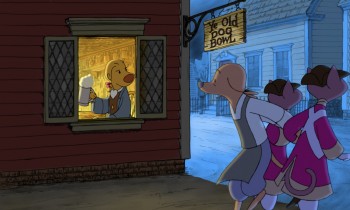 I grew up watching Robin Hood because it was the only Disney movie we had. At some point I saw Ben and Me and I have always liked that one a lot too. I like allegorical story telling, fables… so it seemed natural to tell the story with animals. In a way it lightens up the mood of it having a political bent- because really, they are talking dogs and cats.
I grew up watching Robin Hood because it was the only Disney movie we had. At some point I saw Ben and Me and I have always liked that one a lot too. I like allegorical story telling, fables… so it seemed natural to tell the story with animals. In a way it lightens up the mood of it having a political bent- because really, they are talking dogs and cats.
Bert – We initially considered making a film about the first Thanksgiving with cats as pilgrims and birds as the native Americans. We moved ahead in time a bit and did the Boston Tea Party instead.
I’m sure you don’t want to discuss your budget, but you must have gotten a lot of incredibly talented people to volunteer to help you make the film. (Eric Goldberg, Mark Henn et al). The expense easily looks quite high.
Michael - Was the budget completely out of pocket?
- How did you create such enthusiasm for the project to do so?
- Now that you’ve finished what is your hope for distribution or future development?
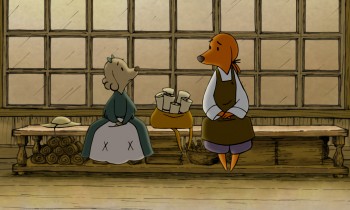 Jennifer – Our budget was all out of our own pocket. We might be a little crazy I guess, but this is what we do. It’s our hobby. Bert and I are very passionate about making shorts, and when we began the project we were also very interested in keeping ourselves in practice for 2d animation at a time when there weren’t any other 2d features being made at any of the studios. Our friends who worked traditionally started to hear about the film and we would have evenings with everyone over and do pencil tests and see them cut into the storyreel – and we’d always have pie, I would bake every night for the crew. The nights started to take on a family atmosphere, and I think everyone felt very comfortable to come and practice their art that they had been trained to do. Everyone was working at their highest skill level– Mark Henn was doing 20 feet a week, James Lopez stretched himself and all of our layouts, we had cleanup people doing the most beautiful work I had ever seen from them. I can’t say how we “created” enthusiasm because you can’t consciously create something like this. You’re just darned lucky that it happens.
Jennifer – Our budget was all out of our own pocket. We might be a little crazy I guess, but this is what we do. It’s our hobby. Bert and I are very passionate about making shorts, and when we began the project we were also very interested in keeping ourselves in practice for 2d animation at a time when there weren’t any other 2d features being made at any of the studios. Our friends who worked traditionally started to hear about the film and we would have evenings with everyone over and do pencil tests and see them cut into the storyreel – and we’d always have pie, I would bake every night for the crew. The nights started to take on a family atmosphere, and I think everyone felt very comfortable to come and practice their art that they had been trained to do. Everyone was working at their highest skill level– Mark Henn was doing 20 feet a week, James Lopez stretched himself and all of our layouts, we had cleanup people doing the most beautiful work I had ever seen from them. I can’t say how we “created” enthusiasm because you can’t consciously create something like this. You’re just darned lucky that it happens.
We are submitting the Pups to film festivals, so we will have about 2 years worth of that, and then we’ll see what happens. My biggest hope would be for a series. I would also love to see it in the classroom one day.
Michael – It must have taken quite some time since I doubt you were able to work steadily on the film and had to fit it in between other jobs. (I’ve seen your resume and know you’ve been busy outside of this film.)
- How long did it take to make, given your work schedule?
- How were you able to maintain such a consistent (and consistently high level) look while working on it on a long, piecemeal schedule? (Assuming that was the case?)
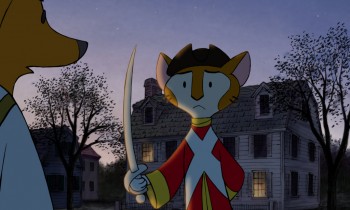 Bert – Most of the production took place during spare time over a two year period. The births of our two kids stretched out the last bits almost another two years.
Bert – Most of the production took place during spare time over a two year period. The births of our two kids stretched out the last bits almost another two years.
One way we ensured consistency was having Jennifer do clean up keys over the different animators’ drawings to maintain the style. Mark Henn did a lot of animation on the film and helped raise the bar for everyone else. One person (James Lopez who was a supervising animator at Disney for a decade) did all of the layouts. I animated a lot of it myself and just kept working on it until it was done. Our assistant director Hyun-Min Lee was invaluable to us in getting this done, tackling technical problems, organizing scenes and x-sheets, and trackreading amongst many other jobs.
Jennifer – I took some time off to work on the film, so I was able to dedicate all of my time to it. I did the boards, designed the characters, did reds for the cleanup keys. I think that the simplicity of the characters saved us a lot of line mileage and made it possible for the artists to get through the footage quickly. They also look best against the backgrounds, which are done in a hand drawn pen-and-ink style and required something simple to contrast with them. We looked at the printwork from the time for inspiration- Paul Revere’s engravings especially really had a ‘homemade’ colonial feel, and you can see his personality in them and in the brush strokes of color used that we tried to invoke.
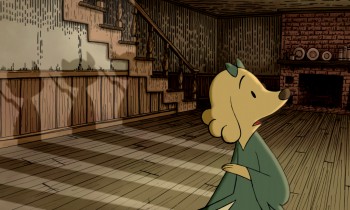 It is hard to sit down and work after you have worked a full day, but I always remembered something Bert would say- “Even if you just get one drawing done you are one drawing ahead.” So I’d try and get one scene’s worth of layouts done a night, or read a track, or just something, and we’d inch forward until we were done.
It is hard to sit down and work after you have worked a full day, but I always remembered something Bert would say- “Even if you just get one drawing done you are one drawing ahead.” So I’d try and get one scene’s worth of layouts done a night, or read a track, or just something, and we’d inch forward until we were done.
Michael – Just as American Tail was compared to MAUS, your film has already received a comment on Cartoon Brew comparing it. There are very obvious differences, but I wonder if you thought about this possibility?
- Or worried about it?
- Did you ever question the idea of doing it with humans?
- Or would that have made you focus even more on historical accuracy?
Bert – I heard of MAUS, but I’ve never read it. Our main reason to make this was purely a labor of love. I watched Jennifer do great work as a story artist on lots of feature projects for studios that never got made or changed radically from the first inception. She was one of the original story artists on Where the Wild Things Are when it was a fully animated feature back in 2001. I wanted to produce a film that was a showcase for her story sensibilities because I felt that it might be the only way to get that pure vision to the screen. We also hope that people and their kids can enjoy it.
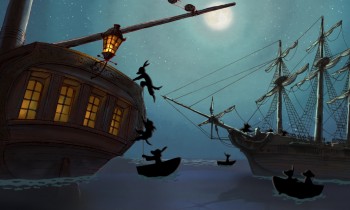 Jennifer – Honestly I never heard of Maus. Whatever subject matter you make a film about though, there will always be something to compare it to — how many films are there about aliens? Or zoo animals? A setting is just a setting- it’s how you hook the audience in, how you make them really feel for and believe in your characters, and the experience that you give them that matters.
Jennifer – Honestly I never heard of Maus. Whatever subject matter you make a film about though, there will always be something to compare it to — how many films are there about aliens? Or zoo animals? A setting is just a setting- it’s how you hook the audience in, how you make them really feel for and believe in your characters, and the experience that you give them that matters.
Doing a historical film with humans instantly makes it more serious- doing it with animals, you can’t take it as seriously and you can have more fun with it. Why animate humans when you can animate talking dogs? It made us laugh. We did it this way so that we could have some fun, and do what we love to do.
Animation &Disney &Frame Grabs 09 Sep 2009 07:43 am
Fantasia FX
- Herman Schultheis was an effects animator who worked on Fantasia. He kept a tight record of the effects they were creating from 1938-1941 and a photo display of how they were done. Schultheis disappeared in 1954 while trekking through Central America, and the notebook was forgotten until his wife’s death in the early 1990s, after which it was discovered by Howard Lowery behind the couple’s bedroom wall.
The book will be on display at the The Walt Disney Family Museum when it opens in October. It’s also been digitized so that visitors will be able to go through the book, enlarge photos and view it page by page.
Prior to the discovery of the book we were able to figure out a few of the effects. One Disneyland show, in fact, recreated the bubbling lava scene from the Rite of Spring sequence.
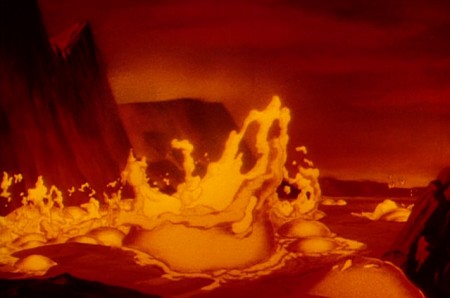
(Click any image to enlarge.)
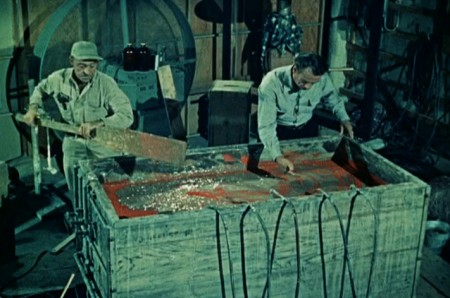
Josh Meador recreated the slow motion shoot of the
boiling concoction used to develop the bubbling lava.
However, the book revealed so much more than we’d understood
about how the superb effects had been crafted.
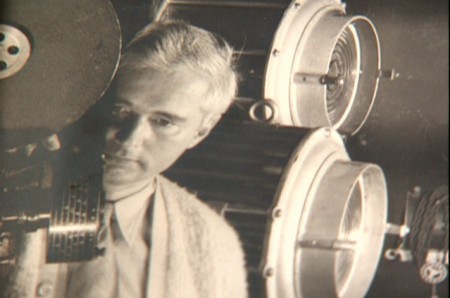
Herman Schultheis created the book of charts and photos
which gives us a link to the many creative effects in the film.
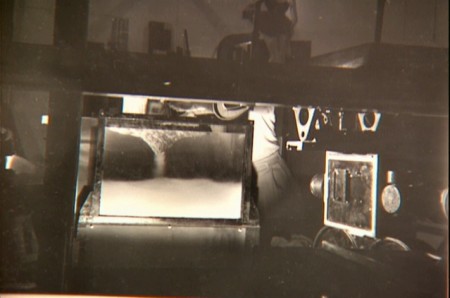
Using a vat of water, they were able to
drop ink into the liquid and film it in slow motion.
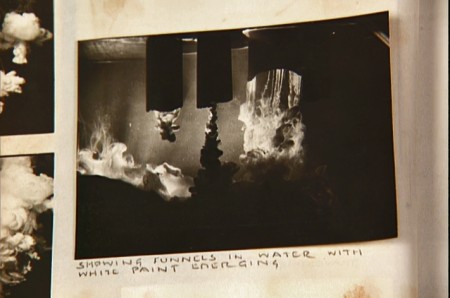
A photo of the ink spilling into the water behind built-in mattes.
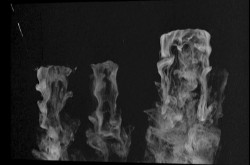
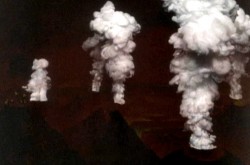
Taking the shot of the ink, they then turned it upside-down.
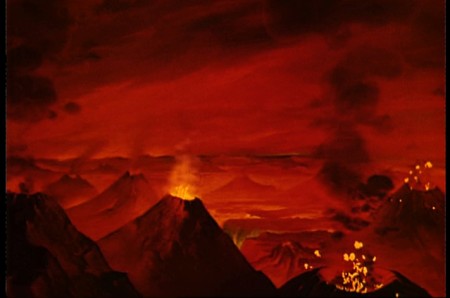
They then superimpose the “smoke” (or ink) over the volcanoes.
This same effect was used in Close Encounters of the Third Kind
to create clouds when the alien ships were moving in on the
farmhouse where the boy and mother lived.
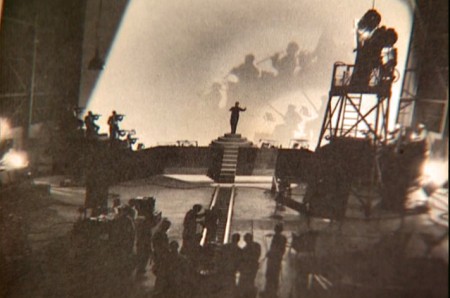
The orchestra was shot on a set with strong, planned shadows.
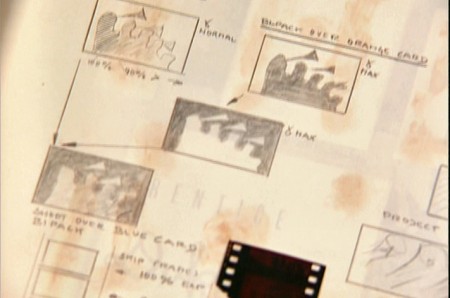
All these shots were orchestrated and planned for color effects.
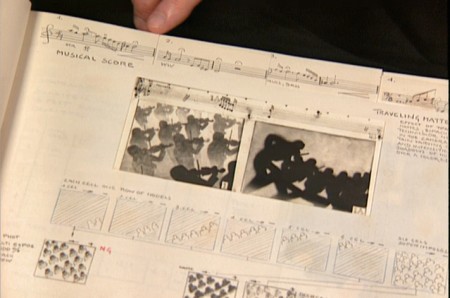
They were also catalogued by Schultheis who kept close
track of the music, as well, in his book. You can see a
page by page breakdown of the score at the top of the page.
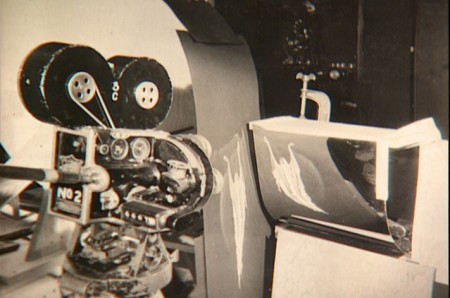
You can see the highly polished sheet of metal (middle left) which reflected
and distorted the animation drawings. This is what the camera photographed
in some of the scenes during the Night on Bald Mountain sequence.
It was also used for the fire in Bambi.
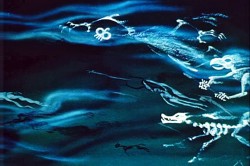 1
1 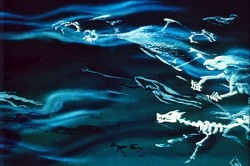 2
2
This scene’s ghosts were shot using that distorted metal reflection.
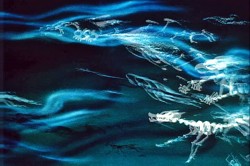 2a
2a 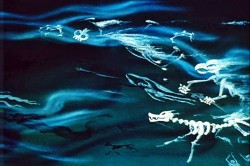 3
3
The ghosts also used a form of cross dissolve.
John Hubley explained to me how that was done.
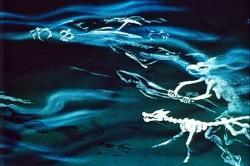 4
4 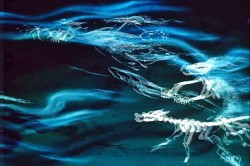 4a
4a
They shot the entire scene at 50% exposure. Then they went back
to the beginning and reshot the entire scene again at 50% exposure.
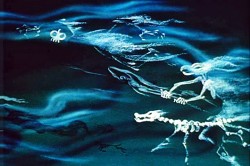 5
5 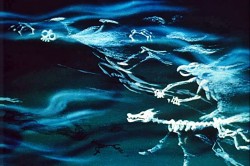 6
6
However on the second shoot, they started by shooting a black frame.
This made #1 fall where #2 should have been, #2 for #3 etc.
This creates a ghostly dissolve effect.
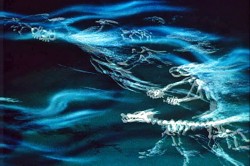 6a
6a 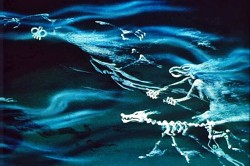 7
7
All of the drawings labelled with an “a” are the double exposures:
2a, 4a, 6a
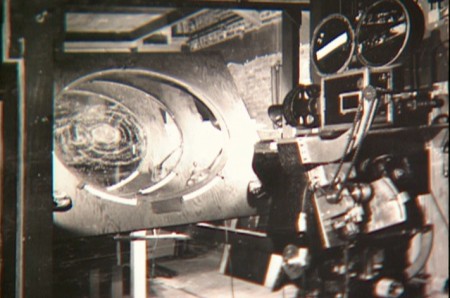
A make-shift circular multiplane camera was built.
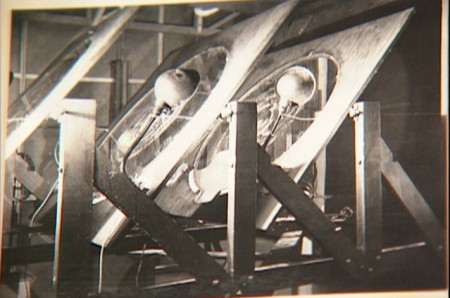
Created out of wooden sheets with holes cut out,
placed so they could shift angles, they were designed to
allow revolving artwork in the circular cut outs.

This allowed shooting scenes such as this shot of
a spider web as the camera turned around it while
dew glistened off it.
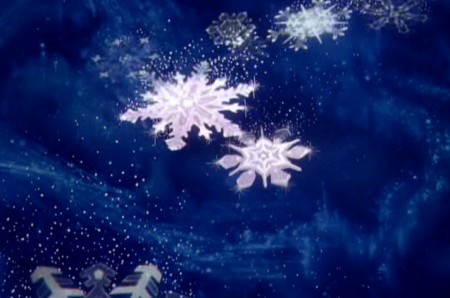
The spinning snowflakes are well explained in Schultheis’ book.
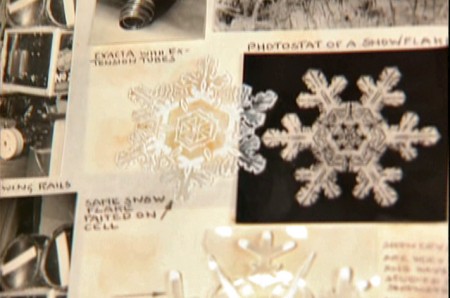
The snowflakes had a detailed construction.
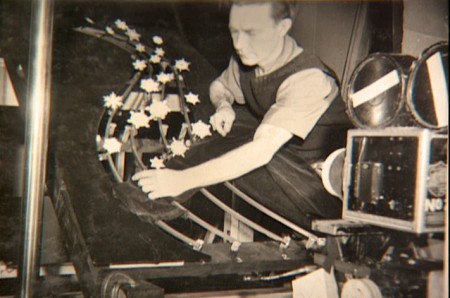
The path of action was intricately defined.
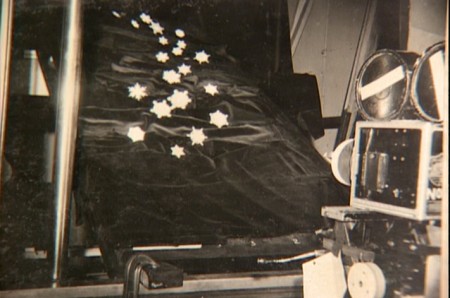
The snowflakes were shot against a sheet of black velvet
hiding the wire guides.
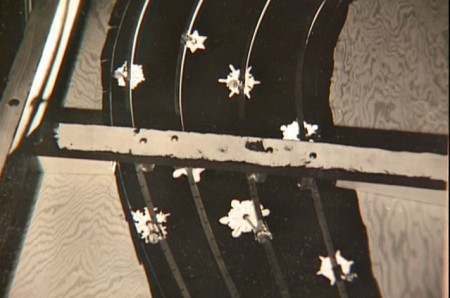
They were shot in tight closeup. From below you can
see the turning gears they were constructed on.
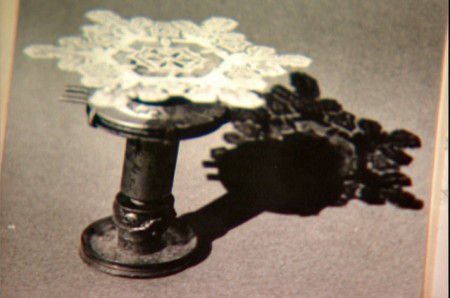
Each snowflake was built on a turning gear
so that they could revolve in their path of action.
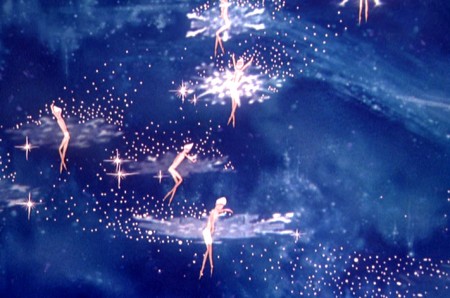
Burn these snowflakes over the multiplane background
and add matching 2D animated fairies within each snowflake,
and you have the finished scene.
Animation Artifacts &Bill Peckmann &Books &Disney &Models 08 Sep 2009 07:35 am
Nutcracker Models
- And speaking of the Nutcracker sequence from Fantasia, here are some models from Bill Peckmann‘s extraordinary collection of that sequece. This is probably my favorite of the sections of that feature. There’s some beautiful character animation within it, excellent effects and conceptually the images and music match.
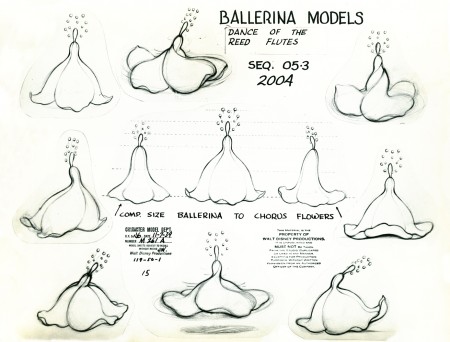 1
1(Click any image to enlarge.)
As this last model shows, the original plan for this sequence included a bug orchestra playing the score – whether part or all of it is questionable – there are a lot of models, drawings and watercolors left behind.
These can be found dominating the book that was released in 1940. There were books for each of the segments of Fantasia, and The Nutcracker Suite is one of them. Oddly, only few of the illustrations are frame grabs from the film, others feature fairies or few of the other characters who made the sequence. Most of the illustrations are these bug characters that don’t appear in the film.
So, to accompany the beautiful models above, I’ve decided to include the bug illustrations from this book – featured below.
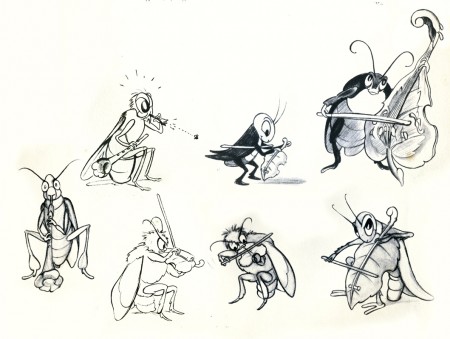 1B&W
1B&W
For more Fantasia items of interest, Bob Cowan is currently showcasing a number of his beautiful pieces on his website.
Animation Artifacts &Bill Peckmann &Disney &Models 24 Aug 2009 07:45 am
Pastoral Models
- The Pastoral sequence of Fantasia is probably the lowest point during the feature. An overly cute sequence in cartoon color glory does the least to support the original score (which has been severely cut by Stokowski from 40 mins down to its 20 min running time.)
The entire sequence can be wrapped up by that one scene where the cupie-doll cupids close out a scene with their fannies forming hearts.
I posted a group of illustrations from this sequence that appeared in the Fantasia book in Sept 2007. You can check that post here if you’d like to compare.
I’ve recently been posting some beautiful model sheets loaned to me by designer/director Bill Peckmann. He has a number of sheets form this sequence of the film, and I thought to post them all together. Here they are:
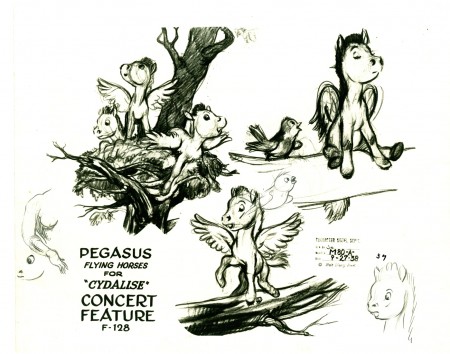
(Click any image to enlarge.)
.
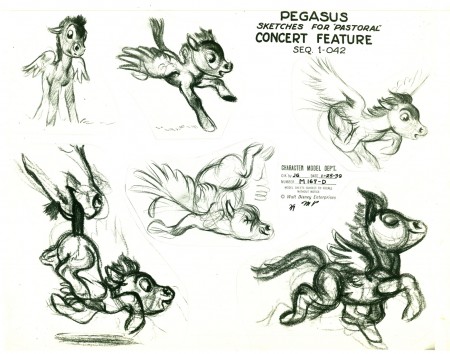
The models start by calling the film “The Concert Feature.”
.
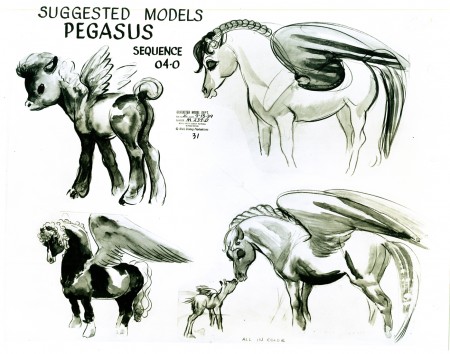
.
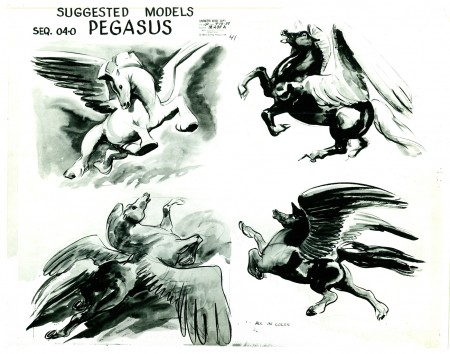
.
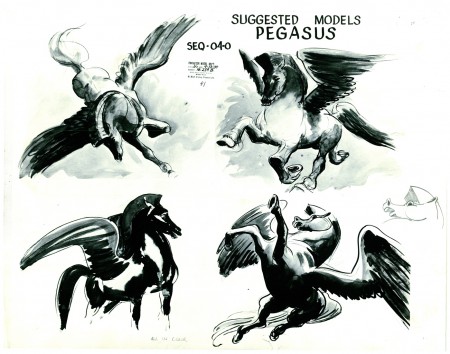
.
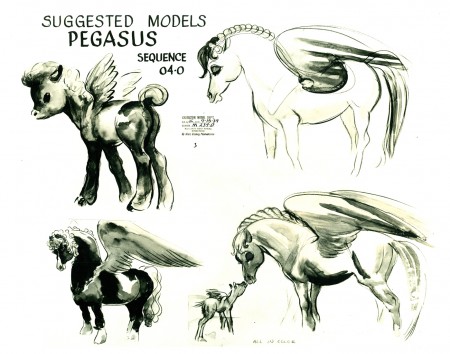
.
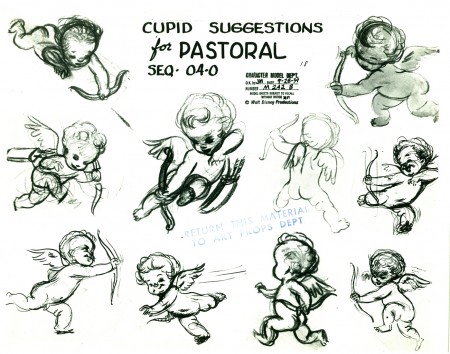
.They soon call the film the “Pastoral.”
.
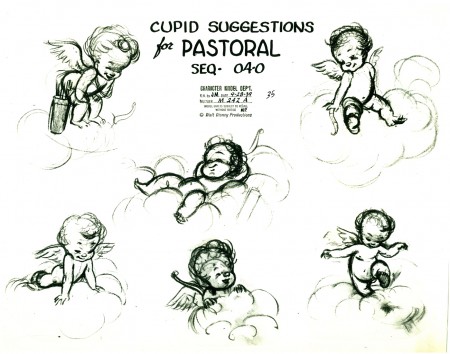
.
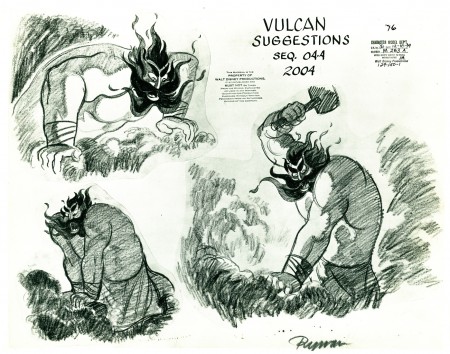
.
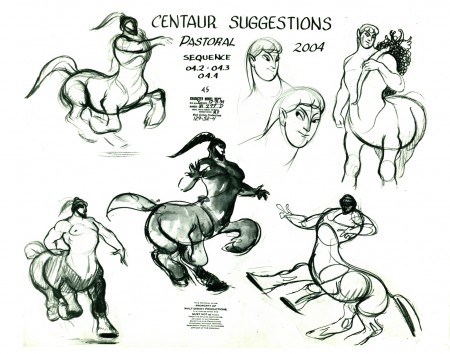
.
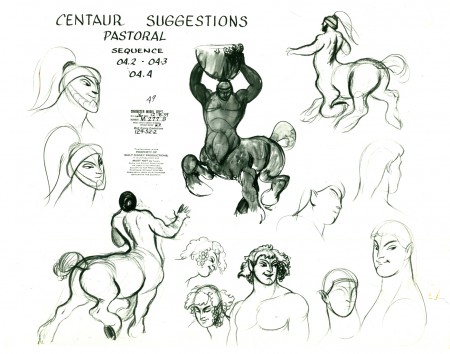
.
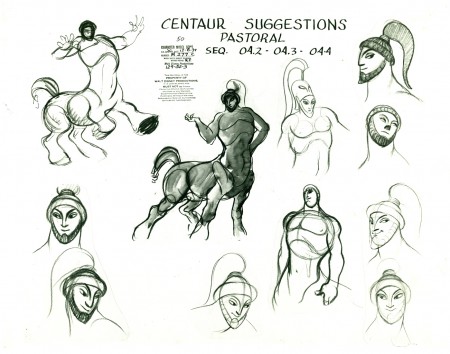
.
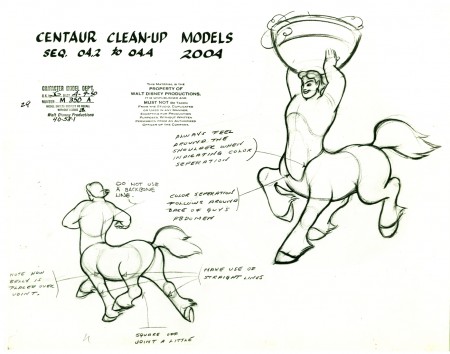
.
It’s interesting to see how loose these clean up models are
in comparison to those of the Xerox/digital era.
.
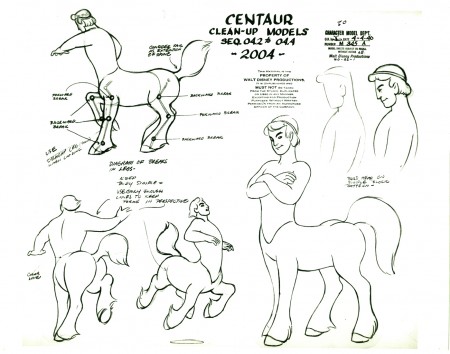
.
They’re probably tight compared to most of today’s assisting.
.
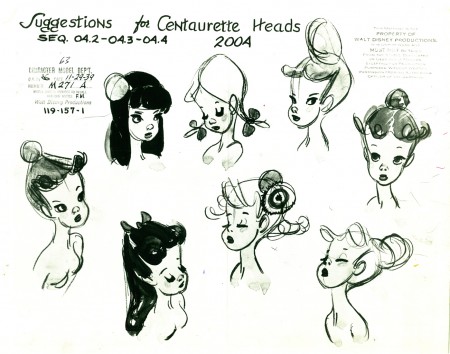
.
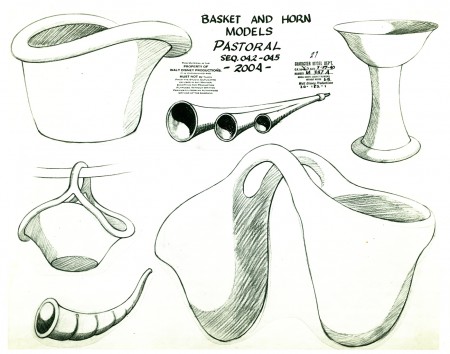
These are the first prop models I’ve seen from this sequence.
.
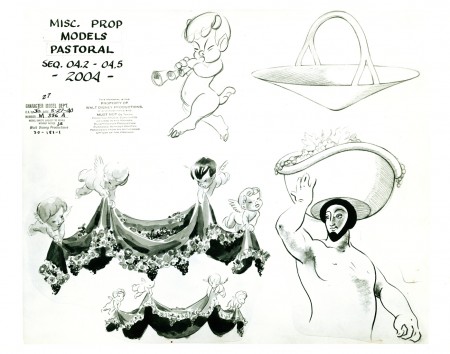
.
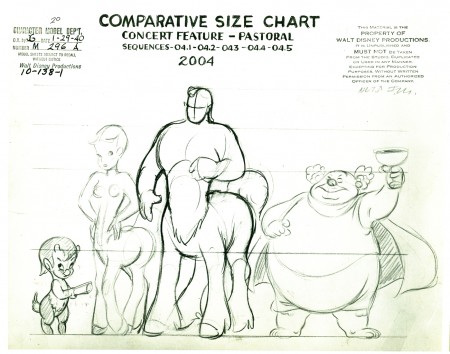
.
Here are two models of hippos from the Dance of the Hours sequence:
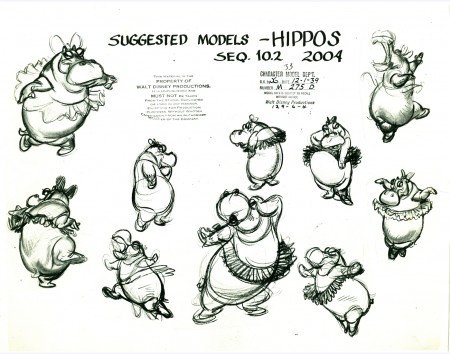
.
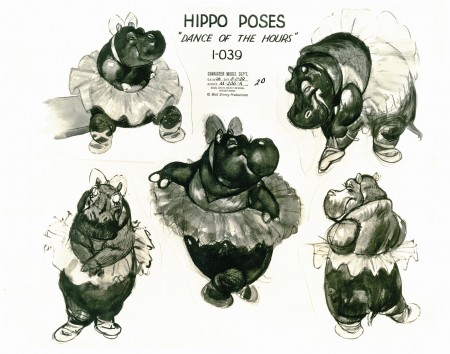
.
And finally, something to cleanse the pallette, a model for a sequence cut from the Nutcracker Suite:
.
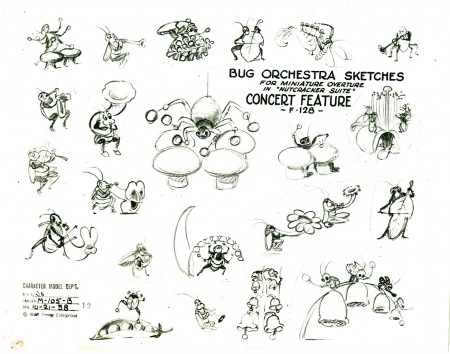
.
Again, many thanks to Bill Peckmann for the loan of these great models.
Bob Cowan, has just started posting some material from Fantasia on his site. His collection is enormous and distinguished. Take a look.
.
Articles on Animation 11 Aug 2009 07:24 am
Jules Engel on Teaching / 1976
- Here’s an article from the Feb. 1976 issue of Millimeter. It’s part of an article written by three separate Animation instructors: Yvonee Anderson (Yellow Ball Workshop), Greg Shelton (J.Marshall High School, Ind.), and Jules Engel (CalArts).
This is the piece written by Mr. Engel:

________________________________ by Jules Engel
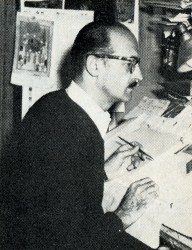 When the Polish animator Jan Lenica toured America last year, he ended up in Los Angeles and came to visit California Institute of the Arts. After seeing a program of films made by the animation students at the Institute, he exclaimed in astonishment, “But these are not student films; they are films by artists! And here in Hollywood! Who would have thought?”
When the Polish animator Jan Lenica toured America last year, he ended up in Los Angeles and came to visit California Institute of the Arts. After seeing a program of films made by the animation students at the Institute, he exclaimed in astonishment, “But these are not student films; they are films by artists! And here in Hollywood! Who would have thought?”
Lenica is not the only one to have said this about Cal Arts and its animated “student” films, but the comments of so great an artist are particularly gratifying—and particularly revealing.
I began working with animation at the Disney Studios in the 40′s when FANTASIA was under production. I was one of about I200 people employed in the Disney
________ Jules Engel ___________ Studio—many of whose names are never recorded, though their contributions to the artistry of the films was considerable. I was hired as a choreography consultant for the Chinese and Russian dancers in the “Nutcracker Suite,” but
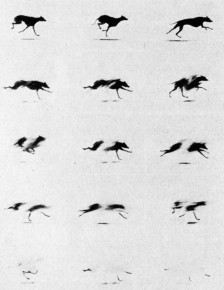 I drew out exacting choreography sketches for both sequences—up to 50 pictures for a one-minute movement—which were then passed on through countless hands (background artists, character animators, in-betweeners, eel painters, etc., etc.) before the finished film was able to be seen. Miraculously, many of my original conceptions—for example, the pure black backgrounds for the low-angle perspectives on the twirling Russian flowers—and the choreography on the Chinese and Russian dance actually survived into the final product!
I drew out exacting choreography sketches for both sequences—up to 50 pictures for a one-minute movement—which were then passed on through countless hands (background artists, character animators, in-betweeners, eel painters, etc., etc.) before the finished film was able to be seen. Miraculously, many of my original conceptions—for example, the pure black backgrounds for the low-angle perspectives on the twirling Russian flowers—and the choreography on the Chinese and Russian dance actually survived into the final product!
Later we founded UPA and opened up other possibilities of this much-maligned medium. With only about a handful of people, we were able to produce artistically integrated works. As a measure of our success, people quickly came to regard American animation in terms of two poles — ________ Engels “Accidents”
the Disney style, and the UPA style (always different,
with a range of subject matter and visual technique as broad as Modern Art itself). And “Disney” soon enough came under the influence of UPA by introducing more stylized elements into their previously realism-oriented product.
After UPA, I produced animation films independently with my own Format Films, including, in addition to Popeye cartoons and various commercials, a film based on a Ray Bradbury story, Icarus, which won an Academy Award nomination and a Gold Medal at the Atlanta Film Festival.
I had been offered jobs teaching painting and sculpture many times, but I had always refused, because I don’t really believe you can teach “art.” The ideas, feelings and meanings of artwork must come from inside the artist. You learn concepts and attitudes, techniques and materials of production. It is always better for the artist to learn about his art by trial and error. We learn through experience and experiencing.
But Cal Arts is different. When Anais Nin recommended me to Herb Blau, and then Robert Corrigan asked me to develop an animation program there, I accepted because I knew I wouldn’t be expected to teach “how” or “what” since the school is conceived as an artists’ conglomerate, as a co-operative workshop where painters and dancers, musicians and actors, philosophers and filmmakers could share their talents and experiences with each other. If one learns by a “how to do” method, one does not reveal one’s self, one only reveals the skill for doing.
Don’t take—search!
I don’t call myself a teacher, and I don’t consider the people I work with as students. They are “talents” or “artists” or “friends.” I hate to hear people say, “I taught him everything he knows.” That’s not education. In the first place, if “everything he knows” can be measured and categorized so easily, “it” must not be too much or too complex, and in the second place, education should be a process of opening and broadening horizons, so if “everything” has supposedly already been “taught,” the process must have been one of closing off possibilities rather than opening them up. Furthermore, a “student” must always have the feeling that he is working for and by himself, developing his own potentials, his own initiatives, his own ideas—not being obliged to or dependent on a “teacher.”
At Cal Arts I have something of an ideal situation. The working environment is not classroom oriented—but more like a working artist’s studio. It is an environment in which experiencing can take place. Studio is open 24 hours and seven days a week. An artist has no limits of working hours! Almost all of the exchange between me and my “talents” is on a one-to-one basis, since out of the 30-or-so talents I work with each year, there are maybe 20 different directions they want to go in.
I never discourage people, and I never force them. Work with the talent where he is, and not where you think he should be. I like to take chances on people and let them find out how they feel about animation. I encourage them to play around with the medium, and some fall in love with it while others learn that it’s not really a vehicle they find satisfying or profitable for their ideas or capabilities. In addition to my 30 full-time talents, I usually have I0 or I5 other talents who come in from other schools (dance, music, design, art) to try out animation. I never say no to anyone, because, after all, with young talent who can say which one is going to develop into something great? I end up working with a Jot of talents. I’m looking for the innovators, (as well as for the craftsman), the dreamers, the leaders. The great artists of animation—the Lenicas, the Fischingers, the Kuris, McLarrens, Hublys, Disney, undoubtedly weren’t model students (and maybe weren’t even pleasant people) because their genius was too eccentric. They broke all the rules, and invented new ones, and that’s precisely why we admire them.
The talents I have come to me from widely varying backgrounds, too. Dennis Pies, for example, had four years of art school behind him and wanted to explore film as a means of adding a controlled time dimension to his paintings, which he did beautifully in films like Aura Corona. Kathy Rose, with a background of a dancer, came on as one of the most intuitive creative artists, winner of the Gold Hugo—at Chicago International (Mirror People). Jane Kirkwood had no experience at all with drawing, yet she produced a superb, award-winning film, drawing for An Exhibition, proof once again that animation is far from synonymous with drawing. Disney himself couldn’t draw all that well. So what!? He was an entertainer. He had the instinct of an actor—and an inspired director. He needed the craftsmen to complete his dreams.
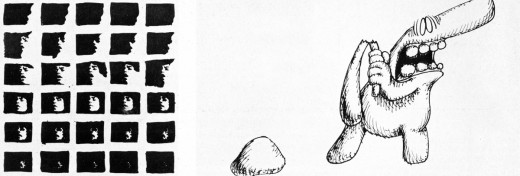
Films produced by students at California Institute of the Arts
Each talent has his own rhythm as well. It takes some people months to get acclimatized to the kind of freedom that I offer in order to find themselves on all levels: intellectual, spiritual, and intuitive. The artist has to discover for himself his own road. Then some talents work very slowly or irregularly, while others like the prodigious Adam Beckett have spent hundreds of hours laboring every day on the drawing board, the Oxberry and the optical printer for each of his five films. The most important part of teaching is not in reading and lecturing or even looking at films, but the actual “doing” of the film.
There is no competition in our classes, either. Competition creates a false sense of artificial tension which might be all right in sports where competitive performance is the only way to demonstrate your skill, but not in art where individuality and individual expression is supremely important. I don’t bother pointing up the talents’ bad points, since they stumble over those soon enough by themselves; I prefer to point up the good points and build on them—to give the talent a confidence in-themselves.
We have excellent equipment and I put together a fine collection of animation films which I show to the talents, and later they can study them for themselves, frame by frame, if they want, on the viewer in the library. We also have guest animators—Americans Mary Ellen Bute and Elfriede Fishcinger, Dragich and Matko from Yugoslavia, Richard Williams and Bob Godfriend from England, Yoji Kuri from Japan, and Dale (Further Adventures of Uncle Sam) Case, Leo Salkin, Herb Klynn, from right here in Hollywood.
Is our program successful? I think our films attest to that. And our talents have had no trouble finding jobs. Joyce Borenstein, for example, is already working for the National Film Board of Canada. If she had tried to learn animation through the studios, she would have spent five years as an in-betweener and five more years as an assistant animator before getting that precious director’s status-symbol, the stopwatch, which they can get the first day in my class and learn to use it at their own pace and in their own way. One day a beginning talent came to me and said, “Oh, I’m sorry about this; look at the mistakes I’ve made!” “No,” I told him, “you can’t make mistakes at this early stage. Mistakes you make later when you know better.” But strange to say, they don’t seem to get around to making too many mistakes later either.
Commentary 30 Jul 2009 07:18 am
Redos
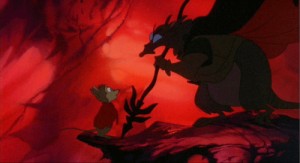 - The news screamed out this week that The Secret of Nimh (otherwise known at Mrs. Frisby and the Rats of NIMH) would be redone by Paramount. Obviously, this wasn’t the film that would save animation, and the new version won’t help much either. It’ll end up a cg/Live Action combination equal to that Guinea Pig
- The news screamed out this week that The Secret of Nimh (otherwise known at Mrs. Frisby and the Rats of NIMH) would be redone by Paramount. Obviously, this wasn’t the film that would save animation, and the new version won’t help much either. It’ll end up a cg/Live Action combination equal to that Guinea Pig
movie that just opened to big box
The old fashioned Secret of NIMH from Don Bluthoffice success.
We’ll have cgi rats and mice running around a live action farm environment chatting away. The film will be written and directed by Neil Burger who did that smash success, The Illusionist, a couple of years back.
One wonders how Don Bluth feels about this. We’ve already had The Chipmunks reanimated in some horrible incarnation of the original Format Films’ animated characters, and we’ve seen Scooby Doo, Garfield and Rocky & Bullwinkle turned into cgi clones of the definitely 2D characters. All terrible movies.
Now we get to witness serious feature animated films reworked into cg monstrosities. Perhaps Disney will take the cue and do a cg/Live Action version of Lady and the Tramp or Snow White or, dare we hope, Fantasia.
I read today about that the “auteur” Zhang Yimou is reamking the Coen Bros. film, Blood Simple. I wonder if any purists would complain if they decided to turn some Live Action gems into cg films. How about Citizen Kane? or Gone With the Wind? The Wizard of Oz is just waiting for the call. After all Tim Burton is doing Alice in Wonderland, and Zemeckis is
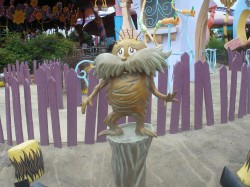 crowing about The Christmas Carol with Jim Carrey doing 10 different roles. (Is there any film that Jim Carrey can’t do?)
crowing about The Christmas Carol with Jim Carrey doing 10 different roles. (Is there any film that Jim Carrey can’t do?)
Word has also come that Universal is about to make Dr. Seuss’ book The Lorax into a 3-D CG animated feature. After the modest financial success of the Blue Sky feature, Horton Hears a Who, why shouldn’t Universal jump into the ring? It has to be better than DePatie-Freleng’s version. At least it’ll stretch the delightful book even longer.
The Lorax
Are there ANY original ideas out there? Has the entire Hollywood world gone so vapid that they can’t come up with anything original?
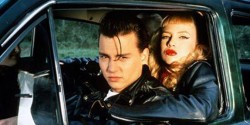 But then this isn’t just the case with Hollywood features; Broadway is going down the same road. There are dozens of shows coming to Broadway that are reworked movie scripts. Everything from 9 To 5 to Cry-Baby have come and gone on the once great thoroughfare (now parking mall, courtesy of Mayor Bloomberg) Broadway. Disney has Cry-Baby the movie
But then this isn’t just the case with Hollywood features; Broadway is going down the same road. There are dozens of shows coming to Broadway that are reworked movie scripts. Everything from 9 To 5 to Cry-Baby have come and gone on the once great thoroughfare (now parking mall, courtesy of Mayor Bloomberg) Broadway. Disney has Cry-Baby the movie
paved the way for many others; The Little Mermaid
is about to close.
Word that 101 Dalmatians, the Musical has been touring everywhere. It’s not a Disney show, but they’re trying to play off the Disney cache. But then, it’s not a Broadway show either, even though “Broadway” is mentioned numerous times on their website. 15 live dalmatians on a theatrical stage; imagine the fun.
It’s obvious that animated films are the last place to find any original thought. Up and Wall-E from Pixar, Shrek and Kung Fu Panda from Dreamworks, Ice Age and The Fantastic Mr. Fox from Blue Sky.
Then the Studios can make live action/animated versions of these films, then Broadway can do their shows. Oh, wait. Shrek is already failing on Broadway. There’s always room for those Madagascar penguins.
Hopefully, Independent animated features will get into the act: the musical Triplettes of Belleville is perfect for Broadway, and I can already see the musical version of Waltz with Bashir and Bill Plympton can try to compete with Mamet with Idiots and Angels.
After writing this, I caught the Cartoon Brew feature about this very thing. I guess it’s enough to catch your breath if you love animation.
Articles on Animation &Commentary 22 Jul 2009 07:12 am
Recap – theories
I’d written this a couple of years ago and posted it then, but I thought I’d expand on it a bit.
I have my own, odd thoughts about animators – great, master animators – these are the only ones I’m talking about.
I think there are two types of animator. Both types, I think, are brilliant but I have my preference. Basically it’s the same breakdown I have with live action actors: the difference between Laurence Oliver and Marlon Brando. Both are geniuses, but I’d go out of my way to see one of them more than the other.
One works from the outside in, and the other works from the inside out. It’s Royal Academy vs. Stanislavsky. 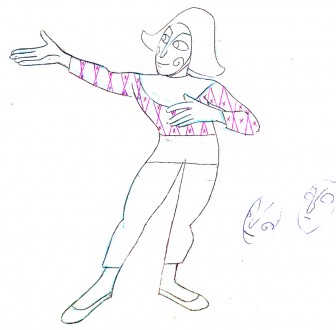
Animators:
- One is a brilliant mechanic of an artist who gets every pose every gesture just right. The movement of the character is perfectly flawless, the accents are always in the right place, the timing is perfect, and the weight captured is exact.
The character is developed but usually in a manipulated, studiously planned way. Usually, this animation, to me, is cold. Give the character a fake nose, and Laurence Olivier could be playing it.
(Art Babbitt, at the top of the triangle, is to me the model for this type of animator.)
(Babbitt dwng of Mime from Hubley’s Everybody Rides the Carousel)
.
Then there is the emotional animator. The poses, gestures, actions of the character are emotionally executed by the animator as if this were the only way it could come out. The drawings are often violent and immediate – pencils ripping through paper and dark blotchy artwork.
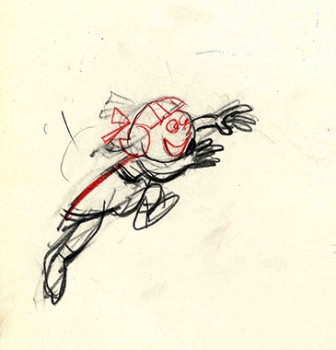 This animator often puts emotion above mechanics, but (s)he digs to the depth of the part to find a real living thing. It isn’t always beautiful, but there’s a gem of a character on the screen. Like any living organism it’s unexpected and natural. Often this type animator works straight ahead (Does dwg#1 first, then #2,
This animator often puts emotion above mechanics, but (s)he digs to the depth of the part to find a real living thing. It isn’t always beautiful, but there’s a gem of a character on the screen. Like any living organism it’s unexpected and natural. Often this type animator works straight ahead (Does dwg#1 first, then #2,
(Grim Natwick, to me, is the prime example of this type.)
No, I’m not saying if you draw dirty, rough, violent drawings you’ll be a great animator. I’m speaking somewhat metaphorically – although the two examples I gave actually did draw that way. I’m sure Art Babbitt did one or two rough,
(Grim Natwick drawing from a Mountain Dew spot.)________violent drawings in his life, but
__________________________________________________his animation feels tight, controlled, yet beautiful. Grim also did one or two clean drawings in his time – I have one, as a matter of fact, but his animation is controlled by his feelings, accumulated knowledge of craft, and emotions. It all feels immediate, spur-of-the moment. It’s alive!
I’ve only ever watched animated films with this guide going in the back of my head. Mind you, also, I have enormous respect for both of these types; it’s just that I prefer the emotional type. More than wanting my characters to think, I want them to feel.
My temptation, here, is to give the obvious list of animators and where they fall in my model, but I think for now I won’t. CGI also fits into this mold, but it’s not a great picture. I’m curious to hear what others think of this model.
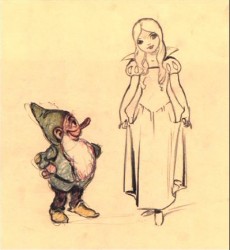 - I don’t mean for this post to turn into a “praise Grim Natwick” nor a “put down Art Babbitt” statement. I hope it doesn’t read that way.
- I don’t mean for this post to turn into a “praise Grim Natwick” nor a “put down Art Babbitt” statement. I hope it doesn’t read that way.
As I’ve said in the past, I treasure the drawings I have that were done by Art. I study and love every frame of any piece he’s ever animated. I just have more fun, personally – and I underline that word, personally, reviewing Grim’s animation.
Marlon Brando wasn’t a better actor than Laurence Olivier. They just came at it from different angles, and my preference has always been the more natural side of the acting world.
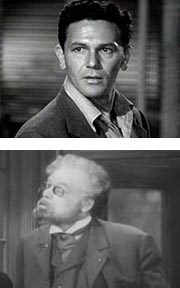 Back in the late thirties when the Group Theater was formed, these actors went to Russia to search out Stanislavsky, an acting teacher who preached at the bible of natural movement – getting in touch with your inner soul to project through the acting.
Back in the late thirties when the Group Theater was formed, these actors went to Russia to search out Stanislavsky, an acting teacher who preached at the bible of natural movement – getting in touch with your inner soul to project through the acting.
On Broadway, recently, was a revival of Awake and Sing. Clifford Odets was a member of the original Group Theater, and his plays reflected their “common man” attitude to theatrical productions. They weren’t trying to do spectacles or Royalty plays, they were trying to project the “average Joe” back from the stage. It changed theater, created Arthur Miller and a whole breed of acting styles. Compare, ex-Group Theater performer, John Garfield’s performances of the thirties with someone who was praised to the hilt back then, Paul Muni. Completely different acting styles – one natural and one overemotional and unrealistic.
The same was and is true of animators’ performances.
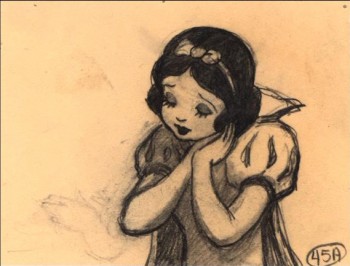 At Disney’s, these guys took their animation seriously. Some, such as Fred Moore and Norm Ferguson, thought they had it right and continued their own paths. Some looked into Stanislavsky and rejected it; others adopted it wholeheartedly. Still others, such as Grim Natwick, did it naturally and always had. Just as in the theater.
At Disney’s, these guys took their animation seriously. Some, such as Fred Moore and Norm Ferguson, thought they had it right and continued their own paths. Some looked into Stanislavsky and rejected it; others adopted it wholeheartedly. Still others, such as Grim Natwick, did it naturally and always had. Just as in the theater.
Next time you look at Fantasia, try just watching the acting styles. There’s nothing more Stanislavsky than Bill Tytla‘s scenes in Night On Bald Mountain, and there’s nothing less Stanislavsky than most of the animation in the Pastoral sequence.
